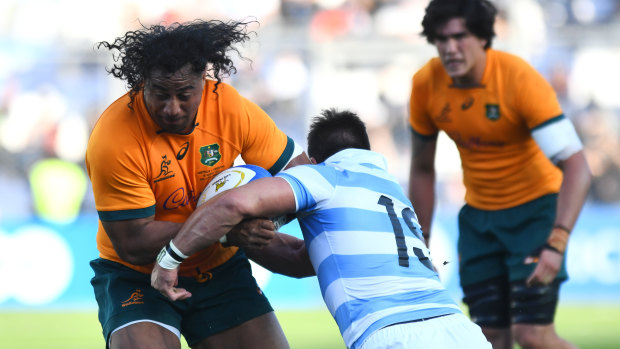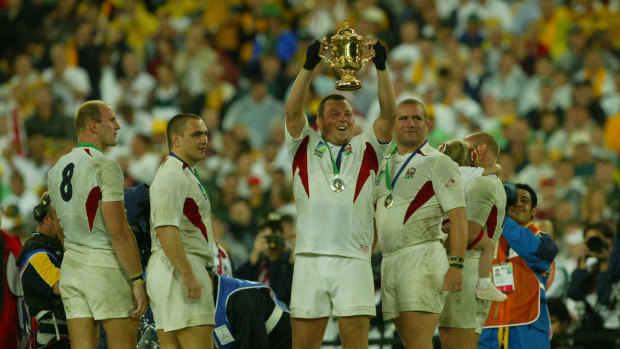Waist-high tackles headed down under, no matter what
Rugby is on a collision course with rugby league in Australia again, but in a much more existential sense than Eddie Jones’s broadsides at Peter V’landys.
You might have missed it, between Rugby Australia’s sensational hiring of Jones last Monday and news on Friday of sex assault charges against Kurtley Beale.
But it came through, nonetheless. A 281-word preview of what is inevitably headed this way, despite what RA and Drew Mitchell might say.
“RFU Council approves reduction in tackle height across community rugby in England,” its headline read.
In community rugby across England in the autumn, children and amateur club players will be taught and forced to tackle from waist-height down, in a move the RFU says will “reduce head impact exposure [and] the risk of concussion”.
The announcement was met with howls of outrage in the UK, mostly because the RFU didn’t talk to a single community rugby club or governing body about the plan, but also because there is widespread wariness about the direction in which the game’s administrators, sports scientists and lawyers are taking it. As of Thursday morning, an online petition protesting the change had attracted almost 75,000 signatures.
A handful of leading English and Irish players criticised the move, along the same lines as Mitchell, who believes it will not make the game safer. Even England’s cricket captain Ben Stokes, whose late father Ged played rugby, skewered the move on Twitter.
Not everyone hates it. England captain Owen Farrell backed the RFU’s decision, as did former England internationals Ugo Monye and Brian Moore. It’s fair to say they’re in the minority.
It was no surprise, then, to see Rugby Australia rule out, for now, introducing something similar. The game has enough points of unfavourable comparison against rugby league, without loading the gun and handing it to V’landys. Increasing sideline intervention versus less sideline intervention, more ball-in-play time versus less, an obscure and never-ending set of laws versus the comparative simplicity of the play-the-ball and set of six. Even the six again. No money versus bucketloads of it.
On the good days, rugby’s complexities make it the most compelling contest going. On the bad days, well … the ARL Commission chair had a point about dipping into your socials to pass the time.
Under a trial in France, the ball carrier cannot drop their height or lead with their head.Credit:Getty
Except, it’s only a matter of time before waist-high tackles will be implemented here. It’s already in use in France, with the added element of banning the ball carrier from dropping their height into the tackle, or bend down and lead with their head. In New Zealand this coming season, community, school and premier club grades will be trialling a reduction in the tackle height from below the shoulders to below the sternum.
World Rugby is the governing body is behind these trials, to varying degrees. Almost 15 years ago, it started trying to manage concussions better in the professional game, and in 2015 started trying to prevent them. Australian Martin Raftery, World Rugby’s chief medical officer for many years, was at the forefront of this process, along with New Zealand scientist Ross Tucker, whose summary of the changes is worth a read.
Now it is a co-defendant, along with the RFU and the Welsh Rugby Union, in a lawsuit brought by 185 former Test and professional players who claim their employers didn’t do enough to protect them from the worst effects of repeated concussions.
Does anyone believe the community game is the end point for the waist-high tackle trial? In seven years the best of the 2023 under-14s will be filtering through to the professional level. This is an attempt to fundamentally and permanently change the game.
2003 World Cup winner Steve Thompson is the face of rugby’s concussion crisis. “I can’t remember it,” he said of the moment just 17 years ago. “I’ve got no feelings about it.”Credit:Dallas Kilponen
Tucker points out that World Rugby, on the recommendation of luminaries including Eddie Jones, Alain Rolland, Paul O’Connell and Agustin Pichot, has tried the softly, softly approach on head injuries which. Oxymoronically, it took the shape of harsh crackdowns on current tackle laws and a growing number of unpopular yellow and red cards accompanied by lengthy stoppages for endless video reviews. The Herald reported on the start of that process in 2016. Every Test and Super Rugby season in the past four years, strewn as they have been with red card ‘atrocities’, refereeing overreach and accusations the game has gone “soft”, has been an indication of how it’s going.
With that approach failing to force change, World Rugby is shifting focus. As well as coercing professional players, it is now getting in on the ground level, at the grassroots.
Unless the RFU and New Zealand Rugby trials throw some data curveballs, expect to see more and more national unions introduce these measures. Australia will be forced to follow suit. It is a matter of time.
The next question is for how much longer will the NRL be able to keep its head in the sand on head injuries? The two rugby codes have many differences, but as collision sports they are both on a path to reckoning on this issue.
Watch all the action from the Six Nations with every match streaming ad-free, live and exclusive on Stan Sport from February 5.
Most Viewed in Sport
From our partners
Source: Read Full Article


